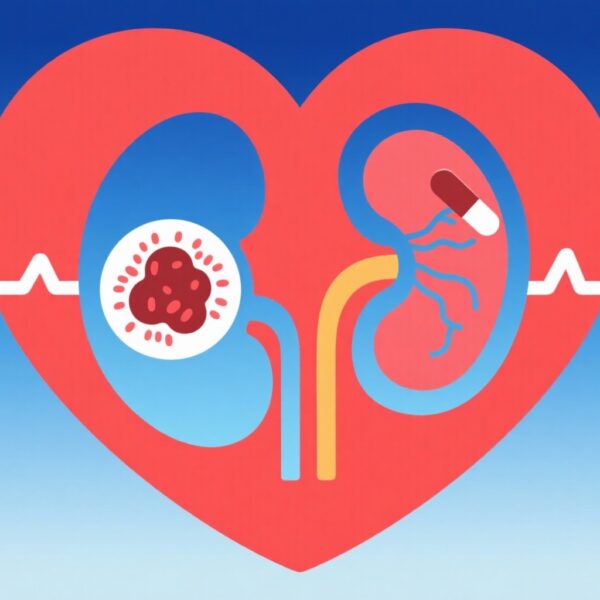Highlights
- The DANFLU-2 trial found no significant benefit of high-dose inactivated influenza vaccine (HD-IIV) over standard-dose (SD-IIV) in preventing influenza/pneumonia hospitalizations, but demonstrated reduced cardiorespiratory hospitalizations driven by cardiovascular disease (CVD), notably heart failure hospitalizations.
- Relative vaccine effectiveness (rVE) benefits of HD-IIV vs SD-IIV were consistent irrespective of baseline cardiovascular disease or atherosclerotic cardiovascular disease status among older adults.
- Meta-analyses and RCTs provide mixed evidence: while some show trends toward cardiovascular benefit with higher-dose vaccines, others report neutral results, underscoring the need for adequately powered, pragmatic, multicenter trials.
- High-dose influenza vaccines elicit stronger immunogenicity but the correlation with improved cardiovascular outcomes remains unconfirmed, highlighting complex pathophysiological mechanisms.
Background
Influenza represents a significant health burden globally, particularly in older adults aged 65 years and older, where it predisposes to severe respiratory complications and exacerbations of cardiovascular and other chronic diseases. Cardiovascular disease (CVD) patients are especially vulnerable to influenza-related morbidity and mortality. Influenza vaccination is recommended to reduce these risks, with evidence supporting protective effects against cardiorespiratory hospitalizations and all-cause mortality. However, vaccine effectiveness in preventing acute cardiovascular events remains incompletely defined, partly due to heterogeneity in populations studied, vaccine formulations, and study designs.
High-dose inactivated influenza vaccines (HD-IIV) have been developed to overcome immunosenescence in older adults, demonstrating enhanced protection against laboratory-confirmed influenza compared to standard-dose vaccines (SD-IIV). While observational studies and smaller randomized controlled trials (RCTs) suggested potential cardiovascular benefits with HD-IIV, robust evidence from large-scale, real-world randomized trials was lacking until recent investigations like the DANFLU-2 trial.
Key Content
1. The DANFLU-2 Trial: A Landmark Investigation
The DANFLU-2 trial, a large pragmatic open-label RCT (NCT05517174), randomized 332,438 Danish older adults (≥65 years) to receive either HD-IIV or SD-IIV across multiple influenza seasons (2022/2023 to 2024/2025). Participants were randomized 1:1 with re-randomization on re-enrollment; 27.4% had a history of cardiovascular disease at baseline.
– Primary Endpoint: Hospitalization for influenza or pneumonia.
– Secondary/Exploratory Endpoints: Hospitalization for cardiorespiratory disease, any cardiovascular disease (CVD), and heart failure.
Results: HD-IIV did not significantly reduce the primary endpoint. However, there was a statistically significant lower incidence of hospitalization for any cardiorespiratory disease (rVE 5.7%; 95% CI, 1.4–9.9%) and any CVD (rVE 7.5%; 95% CI, 1.5–12.5%) in the HD-IIV group. Notably, heart failure hospitalizations were reduced with an rVE of 19.5% (95% CI, 3.3–33.1%). These effects were consistent regardless of baseline cardiovascular history.
2. Complementary Insights from DANFLU-1 and Other RCTs
DANFLU-1, a feasibility trial (NCT05048589) in Denmark, randomized 12,477 adults (65–79 years) to high-dose vs standard-dose quadrivalent influenza vaccine (QIV), assessing hospitalizations for pneumonia or influenza, cardiorespiratory events, and mortality. High-dose vaccination was associated with reduced hospitalizations for pneumonia/influenza and all-cause mortality irrespective of chronic CVD status, although some outcomes were hypothesis-generating due to size and design constraints.
Similarly, the INVESTED trial (NCT02787044) compared high-dose trivalent vs standard-dose quadrivalent influenza vaccines in patients with recent heart failure or myocardial infarction. While high-dose elicited higher antibody titers, no difference was observed in all-cause mortality or cardiopulmonary hospitalizations. Post-vaccination adverse reactions correlated with reduced cardiopulmonary events, possibly reflecting immune responsiveness.
3. Meta-Analyses and Systematic Reviews
A recent meta-analysis including 68,713 patients found no statistically significant advantage of higher-dose influenza vaccines over standard-dose vaccines in preventing major cardiovascular events (pooled relative risk 1.0; 95% CI, 0.93–1.10). Conversely, a systematic review covering over 45 million older adults indicated consistent superior protection of HD-IIV against influenza-like illness and cardiovascular, respiratory, and all-cause hospitalizations across age subgroups and influenza seasons.
4. Mechanisms and Biological Considerations
The biological rationale for vaccine-mediated cardiovascular protection includes prevention of influenza-triggered systemic inflammation, endothelial dysfunction, plaque destabilization, and myocardial injury. HD-IIV induces more robust antibody responses, especially in older adults with immunosenescence, potentially enhancing protection. However, the complexity of immune-cardiovascular interactions and varying vaccine antigenic match might modulate clinical benefits.
5. Safety and Cost-Effectiveness
Postmarketing surveillance data confirm the safety profile of HD-IIV vaccines, with common adverse events being mild injection site reactions. Economic analyses from the Netherlands indicate HD-IIV to be cost-effective in adults aged ≥60 years, primarily driven by prevention of cardiorespiratory hospitalizations and reduced healthcare utilization.
Expert Commentary
The DANFLU-2 trial constitutes a major advance by providing population-level, randomized evidence on HD-IIV versus SD-IIV for cardiovascular outcomes in general older adults. Although the primary endpoint was neutral, secondary analyses suggest HD-IIV may offer meaningful reduction in cardiovascular hospitalizations, especially heart failure, which warrants cautious interpretation given statistical testing limitations.
Concordance with findings from DANFLU-1, INVESTED, and meta-analyses underscores a consistent trend toward benefit, yet the magnitude and robustness of cardiovascular protection remain unclear. Limitations include the pragmatic open-label design and reliance on administrative data for outcome ascertainment. Additionally, heterogeneous definitions of cardiovascular endpoints across studies pose challenges.
Current guidelines endorse influenza vaccination for older adults and those with cardiovascular disease, emphasizing the potential mortality and morbidity benefits. The choice of vaccine dose should consider patient risk profile, vaccine availability, and cost-effectiveness. Mechanistic research and biomarker studies could help identify subgroups most likely to benefit from HD-IIV.
Future trials with longer follow-up, diverse populations, and stratified analyses are essential. Integration of immunogenicity data with clinical outcomes may elucidate the immune correlates of protection against cardiovascular events.
Conclusion
While high-dose influenza vaccination does not conclusively reduce influenza/pneumonia hospitalizations beyond standard-dose in older adults, emerging evidence including the DANFLU-2 study supports a modest protective effect against cardiovascular hospitalizations, notably heart failure. This insight reinforces the imperative for influenza vaccination in cardiovascular risk mitigation strategies among the elderly, recommending HD-IIV as a promising, cost-effective intervention.
Ongoing research should aim to clarify the degree of cardiovascular benefit, optimal vaccine strategies, and integration within comprehensive cardiovascular preventive care.
References
- Johansen ND et al. High-Dose vs Standard-Dose Influenza Vaccine and Cardiovascular Outcomes in Older Adults: A Prespecified Secondary Analysis of the DANFLU-2 Randomized Clinical Trial. JAMA Cardiol. 2025 Aug 30:e253460. doi: 10.1001/jamacardio.2025.3460. PMID: 40884442.
- Johansen ND et al. High-dose vs. standard-dose inactivated influenza vaccine and cardiovascular outcomes in persons with or without pre-existing atherosclerotic cardiovascular disease: the DANFLU-2 trial. Eur Heart J. 2025 Aug 30:ehaf678. doi: 10.1093/eurheartj/ehaf678. PMID: 40884413.
- Biering-Sørensen T et al. Influenza Vaccine Immune Response in Patients With High-Risk Cardiovascular Disease: A Secondary Analysis of the INVESTED Randomized Clinical Trial. JAMA Cardiol. 2024 Jun;9(6):574-581. doi: 10.1001/jamacardio.2024.0468. PMID: 38583091.
- Sagher F et al. Cost-effectiveness of high-dose influenza vaccination in the Netherlands: Incorporating the impact on both respiratory and cardiovascular hospitalizations. Vaccine. 2024 May 31;42(15):3429-3436. doi: 10.1016/j.vaccine.2024.04.040. PMID: 38631948.
- Modin D et al. Relative Effectiveness of High-Dose Versus Standard-Dose Quadrivalent Influenza Vaccine in Older Adults With Cardiovascular Disease: A Prespecified Analysis of the DANFLU-1 Randomized Clinical Trial. Circ Cardiovasc Qual Outcomes. 2025 Feb;18(2):e011496. doi: 10.1161/CIRCOUTCOMES.124.011496. PMID: 39215646.
- Claggett BL et al. Temporal Association Among Influenza-Like Illness, Cardiovascular Events, and Vaccine Dose in Patients With High-Risk Cardiovascular Disease: Secondary Analysis of a Randomized Clinical Trial. JAMA Netw Open. 2023 Sep 5;6(9):e2331284. doi: 10.1001/jamanetworkopen.2023.31284. PMID: 37707817.
- Remschmidt C et al. High-dose influenza vaccine in older adults by age and seasonal characteristics: Systematic review and meta-analysis update. Vaccine X. 2023 Jun 5;14:100327. doi: 10.1016/j.jvacx.2023.100327. PMID: 37333054.
- Clar C et al. Comparing higher-dose and single standard-dose influenza vaccines in preventing cardiovascular events: a meta-analysis with 68,713 patients. Public Health. 2024 Oct;235:71-75. doi: 10.1016/j.puhe.2024.06.034. PMID: 39068775.
- Udell JA et al. Moving the Needle on Atherosclerotic Cardiovascular Disease and Heart Failure with Influenza Vaccination. Curr Atheroscler Rep. 2021 Oct 21;23(12):78. doi: 10.1007/s11883-021-00973-w. PMID: 34671861.


